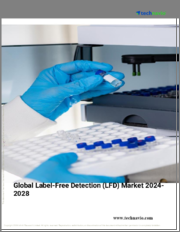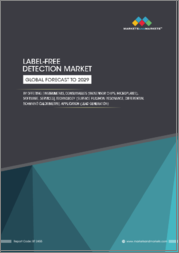
|
시장보고서
상품코드
1623519
세계의 무표지 검출(LFD) 시장 규모 : 기술별, 제품 및 서비스별, 최종 사용자별, 지역별, 범위 및 예측Global Label-Free Detection Market Size By Technology (Surface Plasmon Resonance, Bio-layer Interferometry), By Product & Service (Biosensor Chips, Microplates), By End User (Pharmaceutical & Biotechnology Companies), By Geographic Scope And Forecast |
||||||
무표지 검출(LFD) 시장 규모 및 예측
무표지 검출(LFD) 시장 규모는 2023년에 20억 9,000만 달러로 평가되었고, 2024년부터 2030년에 걸쳐 14.1%의 연평균 복합 성장률(CAGR)로 성장하여 2030년에는 56억 2,000만 달러에 달할 것으로 예측됩니다. 이 시장 성장의 원동력은 첨단 기술 제품의 소개, 산학 제휴에 의한 창약 프로그램 증가, 무표지 기술의 고감도화입니다. 이 조사 보고서는 세계의 무표지 검출(LFD) 시장을 종합적으로 평가하고 있습니다. 경쟁 구도, 시장에서 중요한 역할을 하는 요인 등을 종합적으로 분석했습니다.
세계의 무표지 검출(LFD) 시장 정의
"무표지 검출(LFD) 시스템"으로 알려진 유형의 통합 시스템은 라벨이나 자가 형광 효과를 낮추지 않고 생체 분자의 상호 작용을 조사하는 데 사용됩니다. 생화학 및 세포 기반 검사는 무표지 검출(LFD) 방법에 따라 생체분자와 그 상호작용을 검출하는 목적으로, 무표지 검출(LFD) 접근법이 사용되고 있습니다. 시장은 기관의 제휴나 창약 프로그램 증가에 의해 발전해 나갈 것으로 예상됩니다.
세계의 무표지 검출(LFD) 시장 개요
의약품·바이오테크놀러지 분야에 있어서 연구 개발 활동의 활성화가 세계 무표지 검출(LFD) 시장을 견인하고 있습니다 제약 활동의 아웃소싱이나 학술 기관에 의한 연구 개발 활동이 급증하는 것이 무표지 검출(LFD) 기술에 대한 높은 수요의 중요한 원인입니다.이 기술은 여러 신호 전달 경로의 복잡성을 효과적으로 관리하기 때문에 수요가 높습니다. 그리고 그 채용을 뒷받침하고 있습니다.
정부와 민간 단체가 공동으로 세미나를 개최하고 무표지 검출(LFD) 기술을 사용하는 이점에 관한 최종 사용자의 인식을 높이는 노력은 시장이 확실히 성장할 것으로 기대되고 있습니다. 무표지 검출(LFD) 기술을 개발하기 위한 기업의 지속적인 노력도 시장의 성장에 기여할 것으로 보입니다. 반면, 무표지 검출(LFD)에 필요한 장비의 비용이 높은 것이 시장의 성장을 제한하는 것으로 간주됩니다. 자유 검출 기술의 다양한 장점에 대한 낮은 인지도도 시장 확장의 장벽이 될 것으로 보입니다.
목차
제1장 세계의 무표지 검출(LFD) 시장 : 서문
- 시장 개요
- 조사 범위
- 전제조건
제2장 주요 요약
제3장 VERIFIED MARKET RESEARCH의 조사 방법
- 데이터 마이닝
- 밸리데이션
- 1차 자료
- 데이터 소스 일람
제4장 세계의 무표지 검출(LFD) 시장 전망
- 개요
- 시장 역학
- 성장 촉진요인
- 성장 억제요인
- 기회
- Porter's Five Forces 모델
- 밸류체인 분석
- 규제 프레임워크
제5장 세계의 무표지 검출(LFD) 시장 : 기술별
- 개요
- 표면 플라즈몬 공명
- 생체층 간섭법
- 등온 적정 칼로리 측정
- 시차 주사 열량 측정
- 기타 Lfd 기술
제6장 세계의 무표지 검출(LFD) 시장 : 제품·서비스별
- 개요
- 기기
- 소모품
- 바이오센서칩
- 마이크로플레이트
제7장 세계의 무표지 검출(LFD) 시장 : 최종 사용자별
- 개요
- 제약·바이오테크놀러지 기업
- 학술기관 및 연구기관
- 수탁연구기관
- 기타 최종 사용자
제8장 세계의 무표지 검출(LFD) 시장 : 지역별
- 개요
- 북미
- 미국
- 캐나다
- 멕시코
- 유럽
- 독일
- 영국
- 프랑스
- 기타 유럽
- 아시아태평양
- 중국
- 일본
- 인도
- 기타 아시아태평양
- 라틴아메리카
- 브라질
- 아르헨티나
- 세계 기타 지역
제9장 세계의 무표지 검출(LFD) 시장 : 경쟁 구도
- 개요
- 기업의 시장 점유율
- 벤더 상황
- 주요 발전 전략
제10장 기업 프로파일
- General Electric
- Danaher Corporation
- Perkinelmer
- Ametek
- F. Hoffman-La Roche AG
- Malvern Panalytical
- TA Instruments
- Corning Incorporated
- Horiba
- Shimadzu Corporation
- Hitachi High-Technologies Corporation
제11장 부록
- 관련 조사
Label-Free Detection Market Size And Forecast
Label-Free Detection Market size was valued at USD 2.09 Billion in 2023 and is projected to reach USD 5.62 Billion by 2030 , growing at a CAGR of 14.1% from 2024 to 2030. Growth during this market is driven by the introduction of technologically advanced products, a growing number of drug discovery programs through academic-industrial partnerships, and thus the high sensitivity of label-free technologies. The Global Label-Free Detection Market report provides a holistic evaluation of the market. The report offers a comprehensive analysis of key segments, trends, drivers, restraints, competitive landscape, and factors that are playing a substantial role in the market.
Global Label-Free Detection Market Definition
The type of integrated systems known as "label-free detection systems" are used to examine biomolecular interactions without lowering the labels or auto-fluorescent effects. These technologies provide a quick and real-time method for finding novel drugs. Biochemical and cell-based tests are detected by label-free detection methods. For the purpose of detecting biomolecules and their interactions, the label-free detection approach is used. This approach has become a wonderful research and development tool for the biotech and pharmaceutical sectors. The market will develop as a result of partnerships between pharmaceutical corporations and academic institutions and the rise in drug discovery programs.
What's inside a VMR industry report?
Our reports include actionable data and forward-looking analysis that help you craft pitches, create business plans, build presentations and write proposals.
Global Label-Free Detection Market Overview
The growing research and development activities within the field of pharmaceuticals and biotechnology are driving the worldwide Label-Free Detection Market. A surge in outsourcing pharmaceutical activities and R&D activities by academic institutions are together responsible for the high demand for label-free detection techniques. These techniques are in high demand as they effectively manage the complexity of multiple signaling pathways. Moreover, label-free detection techniques eliminate the utilization of autofluorescent and spatial interference, boosting their adoption.
Joint efforts by governments and private organizations to organize seminars and increase awareness among end-users regarding the benefits of using label-free detection techniques are expected to ensure the growth of the market. In addition to the current state, continued efforts by businesses to create cutting-edge label-free detection techniques will contribute to the market's growth. On the other hand, the high cost of the equipment required for label-free detection would limit this market's growth. The end-users lack of expertise and poor levels of awareness about the various advantages of label-free detection techniques would also be a barrier to the market's expansion.
Global Label-Free Detection Market Segmentation Analysis
The Global Label-Free Detection Market is Segmented on the basis of Technology, Product & Service, End User, And Geography.
Label-Free Detection Market, By Technology
- Surface Plasmon Resonance
- Bio-layer Interferometry
- Differential Scanning Calorimetry
- Isothermal Titration Calorimetry
- Other Label-free Detection Technologies
Based on Technology, the market is bifurcated into Surface Plasmon Resonance, Bio-layer Interferometry, Differential Scanning Calorimetry, Isothermal Titration Calorimetry, And Other Label-free Detection Technologies. The biosensor chips accounted for the most important share of the consumables segment mainly owing to the high specificity and skill to watch molecular interactions in real-time.
Label-Free Detection Market, By Product & Service
- Biosensor Chips
- Microplates
- Reagents & Kits
Based on Product & Service, the market is bifurcated into Biosensor Chips, Microplates, And Reagents & Kits. The surface plasmon resonance segment accounted for the foremost important share, attributable to the high sensitivity of this technology and its wide usage in determining specificity, affinity, and kinetic parameters during the binding of macromolecules.
Label-Free Detection Market, By End User
- Pharmaceutical & Biotechnology Companies
- Academic & Research Institutes
- Contract Research Organizations (Cros)
- Others
Based on End User, the market is bifurcated into Pharmaceutical & Biotechnology Companies, Academic & Research Institutes, Contract Research Organizations (Cros), And Others. The pharmaceutical & biotechnology companies segment dominated the Label-Free Detection Market, owing to the extensive use of label-free detection technologies by pharmaceutical & biotechnology companies for studying biomolecular interactions in drug discovery.
Label-Free Detection Market, By Geography
- North America
- Europe
- Asia Pacific
- Rest of the world
- On the basis of Regional Analysis, the Global Label-Free Detection Market is classified into North America, Europe, Asia Pacific, and Rest of the world. North America accounted for the most important share of the general market, followed by Europe. The availability of funds for research, increasing research activities in drug discovery and development, growth in pharmaceutical R&D spending, and the presence of key players are the major factors driving the North American market.
Key Players
- The "Global Label-Free Detection Market" study report will provide valuable insight with an emphasis on the global market including some of the major players such as
- Medtronic, Koninklijke Philips N.V., Ambu, Cognionics, Inc., Natus Medical Incorporated, 3M, CONMED Corporation, Rhythmlink International, LLC, Leonhard Lang GmbH (Acquired By DCC PLC.), Nihon Kohden Corporation, Compumedics Limited, G.Tec Medical Engineering GmbH, SOMNOmedics GmbH, NeuroSky, General Healthcare (Subsidiary of General Electric Company).
Our market analysis also entails a section solely dedicated to such major players wherein our analysts provide an insight into the financial statements of all the major players, along with product benchmarking and SWOT analysis. The competitive landscape section also includes key development strategies, market share, and market ranking analysis of the above-mentioned players globally.
TABLE OF CONTENTS
1 INTRODUCTION OF GLOBAL LABEL-FREE DETECTION MARKET
- 1.1 Overview of the Market
- 1.2 Scope of Report
- 1.3 Assumptions
2 EXECUTIVE SUMMARY
3 RESEARCH METHODOLOGY OF VERIFIED MARKET RESEARCH
- 3.1 Data Mining
- 3.2 Validation
- 3.3 Primary Interviews
- 3.4 List of Data Sources
4 GLOBAL LABEL-FREE DETECTION MARKET OUTLOOK
- 4.1 Overview
- 4.2 Market Dynamics
- 4.2.1 Drivers
- 4.2.2 Restraints
- 4.2.3 Opportunities
- 4.3 Porters Five Force Model
- 4.4 Value Chain Analysis
- 4.5 Regulatory Framework
5 GLOBAL LABEL-FREE DETECTION MARKET, BY TECHNOLOGY
- 5.1 Overview
- 5.2 Surface Plasmon Resonance
- 5.3 Bio-Layer Interferometry
- 5.4 Isothermal Titration Calorimetry
- 5.5 Differential Scanning Calorimetry
- 5.6 Other Lfd Technologies
6 GLOBAL LABEL-FREE DETECTION MARKET, BY PRODUCT & SERVICE
- 6.1 Overview
- 6.2 Instruments
- 6.3 Consumables
- 6.3.1 Biosensor Chips
- 6.3.2 Microplates
7 GLOBAL LABEL-FREE DETECTION MARKET, BY END USER
- 7.1 Overview
- 7.2 Pharmaceutical & Biotechnology Companies
- 7.3 Academic & Research Institutes
- 7.4 Contract Research Organizations
- 7.5 Other End Users
8 GLOBAL LABEL-FREE DETECTION MARKET, BY GEOGRAPHY
- 8.1 Overview
- 8.2 North America
- 8.2.1 U.S.
- 8.2.2 Canada
- 8.2.3 Mexico
- 8.3 Europe
- 8.3.1 Germany
- 8.3.2 U.K.
- 8.3.3 France
- 8.3.4 Rest of Europe
- 8.4 Asia Pacific
- 8.4.1 China
- 8.4.2 Japan
- 8.4.3 India
- 8.4.4 Rest of Asia Pacific
- 8.5 Latin America
- 8.5.1 Brazil
- 8.5.2 Argentina
- 8.6 Rest of the World
9 GLOBAL LABEL-FREE DETECTION MARKET COMPETITIVE LANDSCAPE
- 9.1 Overview
- 9.2 Company Market Share
- 9.3 Vendor Landscape
- 9.4 Key Development Strategies
10 COMPANY PROFILES
- 10.1 General Electric
- 10.1.1 Overview
- 10.1.2 Financial Performance
- 10.1.3 Product Outlook
- 10.1.4 Key Developments
- 10.2 Danaher Corporation
- 10.2.1 Overview
- 10.2.2 Financial Performance
- 10.2.3 Product Outlook
- 10.2.4 Key Developments
- 10.3 Perkinelmer
- 10.3.1 Overview
- 10.3.2 Financial Performance
- 10.3.3 Product Outlook
- 10.3.4 Key Developments
- 10.4 Ametek
- 10.4.1 Overview
- 10.4.2 Financial Performance
- 10.4.3 Product Outlook
- 10.4.4 Key Developments
- 10.5 F. Hoffman-La Roche AG
- 10.5.1 Overview
- 10.5.2 Financial Performance
- 10.5.3 Product Outlook
- 10.5.4 Key Developments
- 10.6 Malvern Panalytical
- 10.6.1 Overview
- 10.6.2 Financial Performance
- 10.6.3 Product Outlook
- 10.6.4 Key Developments
- 10.7 TA Instruments
- 10.7.1 Overview
- 10.7.2 Financial Performance
- 10.7.3 Product Outlook
- 10.7.4 Key Developments
- 10.8 Corning Incorporated
- 10.8.1 Overview
- 10.8.2 Financial Performance
- 10.8.3 Product Outlook
- 10.8.4 Key Developments
- 10.9 Horiba
- 10.9.1 Overview
- 10.9.2 Financial Performance
- 10.9.3 Product Outlook
- 10.9.4 Key Developments
- 10.10 Shimadzu Corporation
- 10.10.1 Overview
- 10.10.2 Financial Performance
- 10.10.3 Product Outlook
- 10.10.4 Key Developments
- 10.11 Hitachi High-Technologies Corporation
- 10.11.1 Overview
- 10.11.2 Financial Performance
- 10.11.3 Product Outlook
- 10.11.4 Key Developments
11 Appendix
- 11.1 Related Research



















